Middle East Renewable Energy Market Size
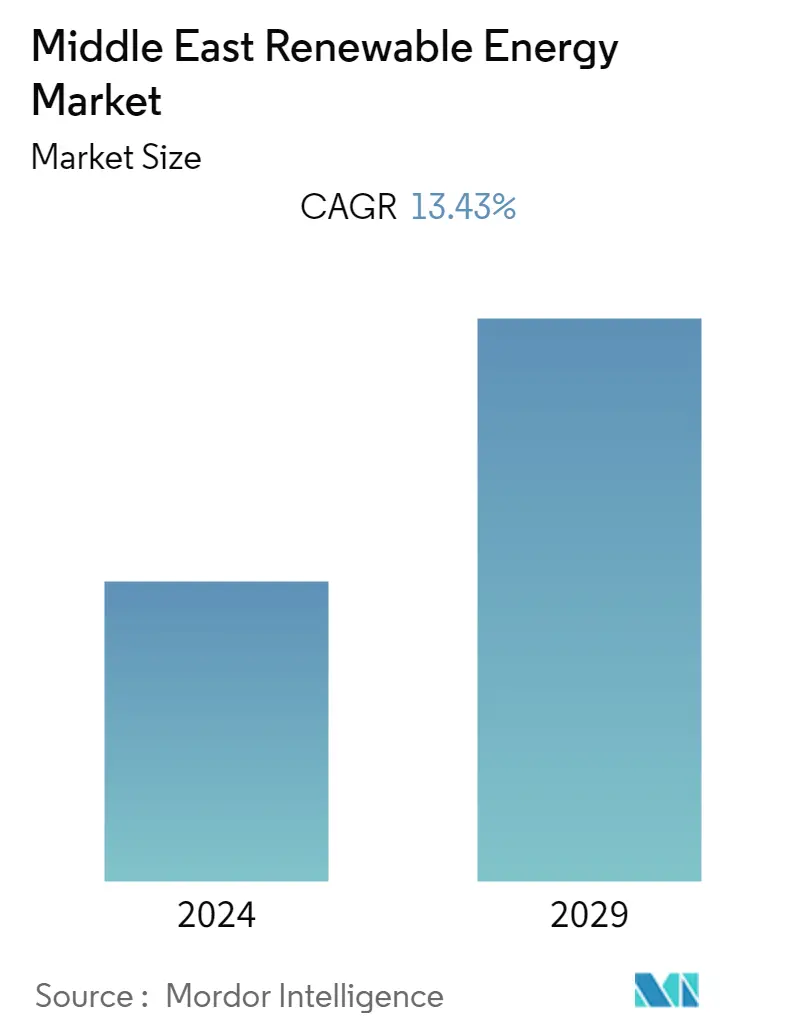
| Study Period | 2020 - 2029 |
| Base Year For Estimation | 2023 |
| Forecast Data Period | 2024 - 2029 |
| Historical Data Period | 2020 - 2022 |
| CAGR | 13.43 % |
| Market Concentration | Medium |
Major Players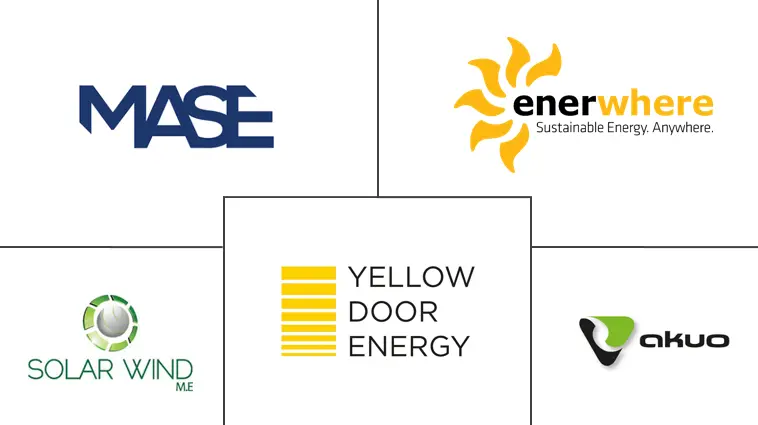
*Disclaimer: Major Players sorted in no particular order |
Middle East Renewable Energy Market Analysis
The Middle Eastern renewable energy market is expected to register a CAGR of around 13.43% during the forecast period. The market has reached pre-pandemic levels though it was negatively impacted by COVID-19 in 2020.
- Over the medium term, factors such as various governments' plans to diversify the energy mix and increase investments in renewable energy are expected to drive the market.
- On the other hand, the increasing penetration of natural gas for power generation and its lower price are expected to restrain the growth of the market during the forecast period.
- Nevertheless, renewable power is an intermittent energy source. Therefore, the storage of electricity is essential to maintain the constant power distribution of generated renewable power. Thus, the increasing integration of renewable energy and energy storage systems is expected to create future market opportunities.
- The United Arab Emirates (UAE) is expected to witness significant growth in the Middle Eastern renewable energy market during the forecast period, owing to upcoming projects and government targets.
Middle East Renewable Energy Market Trends
This section covers the major market trends shaping the Middle East Renewable Energy Market according to our research experts:
Solar Energy Segment to Witness Significant Growth
- In the Middle Eastern region, solar energy plays a vital role in achieving the country's renewable energy target, and it is expected to show significant growth during the forecast period. In 2015, solar power installed capacity in the Middle East was around 1 GW, which increased to 8.4 GW in 2021.
- According to the Global Energy Monitor report, solar and wind power plants that are to be built by Arab Countries will increase the Middle Eastern renewable energy production capacity by five times. Nearly 45 wind power plants and 114 solar power plants are included in this project.
- Furthermore, according to the Pan Arab Clean Energy initiative by the International Renewable Energy Agency, 92% of the target to be attained through renewable energy generation projects in Middle Eastern countries will be reached by 2030. Solar and wind energy generated by these countries will double the region's renewable power generation capacity by 2030.
- Additionally, increasing natural gas prices and decreasing solar PV costs in UAE have made renewable energy more useful. The country is anticipated to achieve 20% of its electricity from non-fossil fuel sources within three years and derives 50% of its energy from these sources by 2050.
- Furthermore, an upcoming project in the Middle East, investing in renewable energy and solar energy to convert from solar farms to E-trees, will mark a revolution in the world. 'E-tree' is reminiscent of a giant shade tree consisting of a funnel-shaped structure that forms an enormous, slanted 360-degree cantilever that hovers above the garden below. It is also surrounded by 19 small 'E-trees,' which help supply an additional 28% of electricity. These trees will track the sun around the day and optimize harvesting the energy by rotation of 180 degrees. These trees also provide shade and stippled sunlight to the gardens below.
- Therefore, owing to the abovementioned factors, solar energy is expected to witness significant growth in the Middle Eastern renewable energy market during the forecast period.
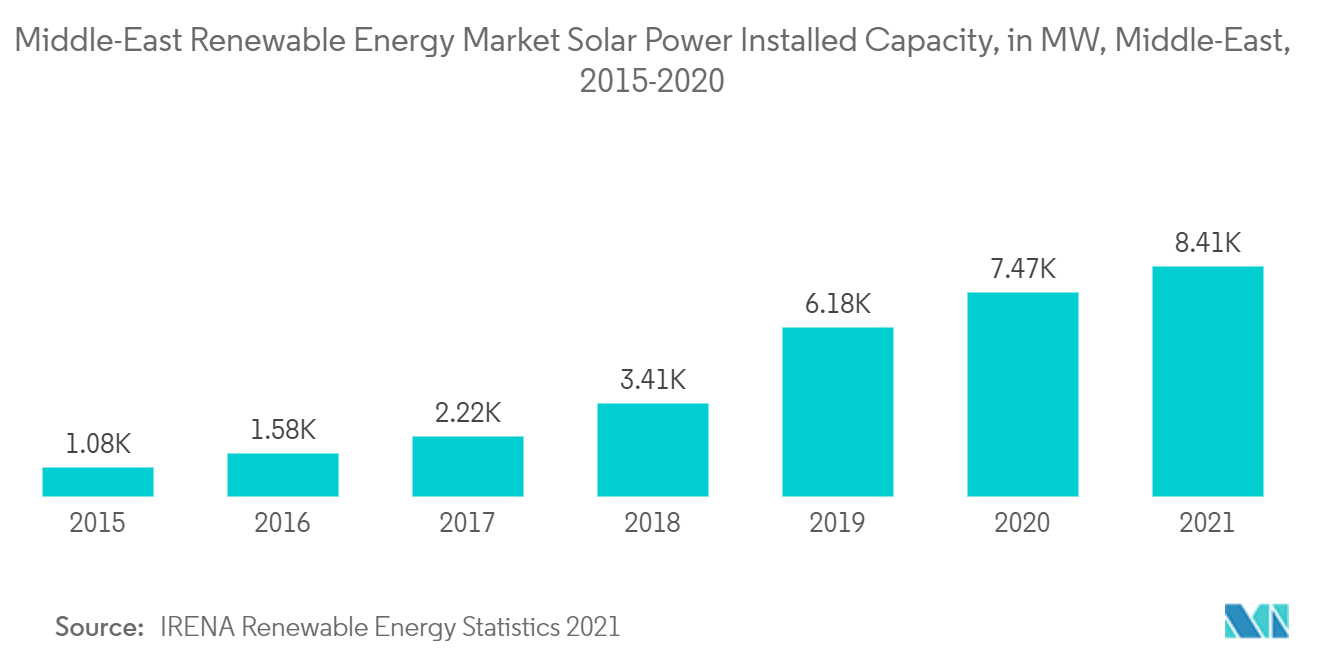
The UAE is Expected to Witness Significant Growth
- The UAE has undertaken significant steps over the past few years, driving the region toward adopting renewable energy, particularly in the solar sector. Renewable energy projects will generate more than 70 GW of power by 2050, witnessing an investment of USD 700 billion.
- Furthermore, to meet the rising demand, the country embarked on a challenging mission to increase its energy security, diversify its energy sources, and increase the share of solar energy in its power mix.
- The country has proven that it has some of the world's best solar resources while supporting economic and regulatory policies and helping its clean energy program. One of the contributing factors is access to affordable finance.
- In addition to conventional project financing, the solar sector is witnessing financial innovation to help facilitate and provide investments required in the long term, including the AED 100 billion Dubai Green Fund to support the Shams Dubai initiative, a program aimed at promoting the installation of rooftop solar panels.
- Further, several factors converged to make solar energy an attractive option, to meet the country's energy needs. The country is geographically well-positioned, with solar irradiance of approximately 2,285 kWh/m2. It has one of the highest solar exposure rates globally, thereby holding tremendous potential for renewable energy development.
- In addition, the declining cost of solar modules and battery technology is increasing solar PV adoption in the United Arab Emirates. As the cost of solar power is declining rapidly, the United Arab Emirates is evaluating its strategies related to the power sector, which currently relies on large subsidies for electricity generated from natural gas or liquefied natural gas (LNG).
- The 'UAE Energy Strategy 2050' aims to increase the contribution of clean energy to the country's overall national energy mix, to 50%, by 2050, thereby saving approximately USD 190 billion of the overall energy costs. It will help reduce carbon emissions by 70% and increase consumption efficiency by 40%.
- The country is committed to tackling climate change and announced joining the International Solar Alliance, which aims to help developing countries harness 1,000 GW of solar power by 2030.
- Therefore, owing to the abovementioned factors, the United Arab Emirates is expected to witness significant growth in the Middle Eastern renewable energy market during the forecast period.
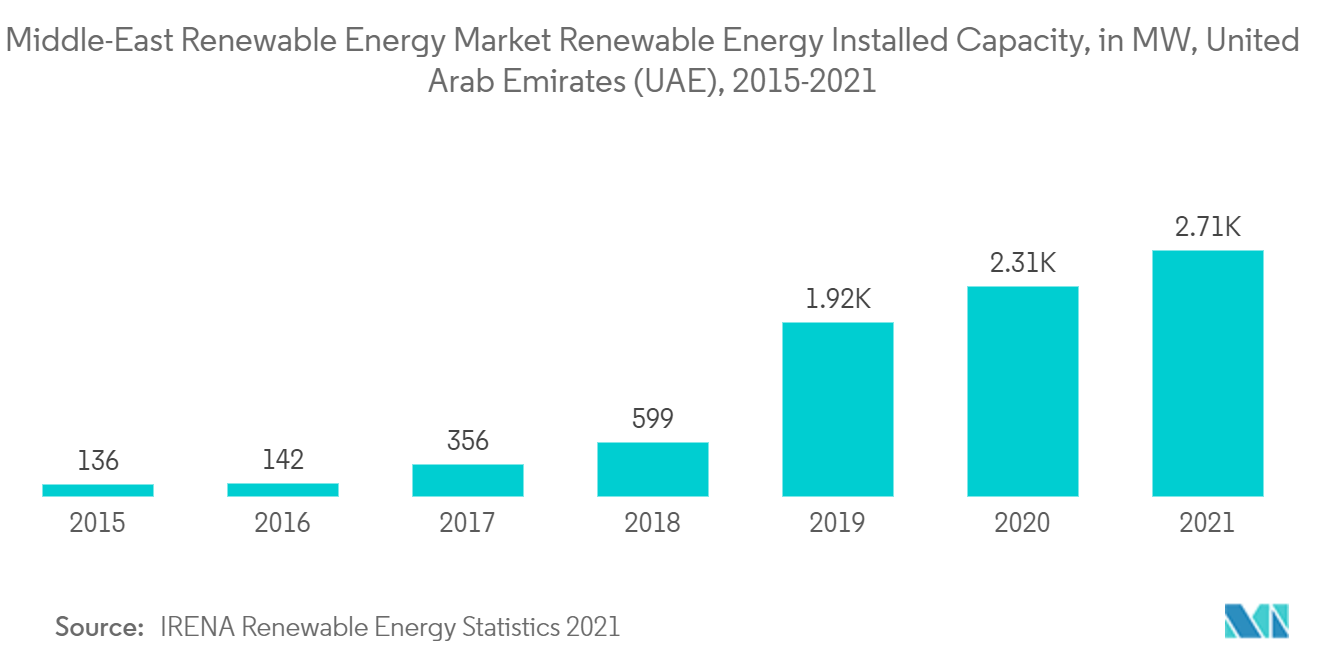
Middle East Renewable Energy Industry Overview
The Middle Eastern renewable energy market is moderately fragmented. Some of the major players in the market include (in no particular order) MASE, Enerwhere Sustainable Energy DMCC, Solarwind ME, Akuo Energy SAS, and Yellow Door Energy.
Middle East Renewable Energy Market Leaders
-
Enerwhere Sustainable Energy DMCC
-
Solarwind M.E.
-
Akuo Energy SAS
-
Yellow Door Energy
-
MASE
*Disclaimer: Major Players sorted in no particular order
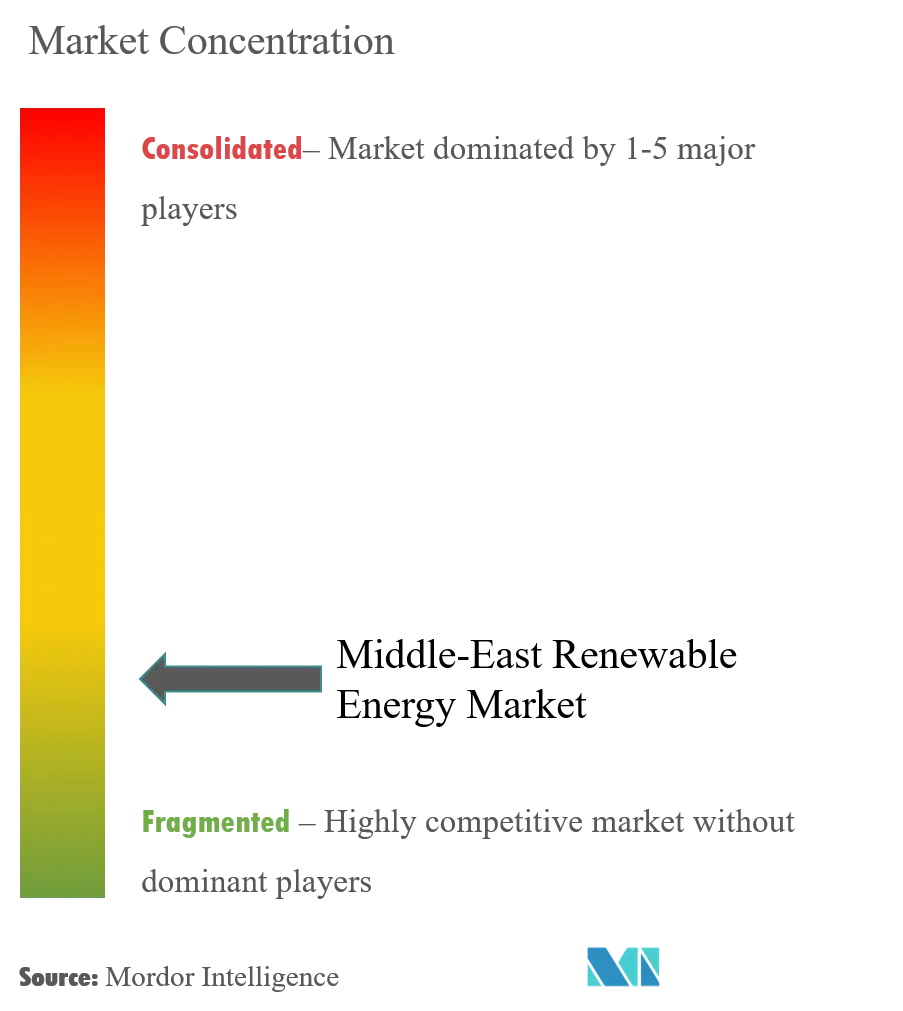
Middle East Renewable Energy Market News
- July 2022: The fourth phase of Mohammed bin Rashid Solar Park was announced to be implemented by Noor Energy 1 PSC, which contains 0.7 GW CSP and 0.25 GW PV, including Parabolic Trough CSP plants of 0.6 GW ( 0.2 GW for each unit) & Molten Salt Tower CSP Plant of 0.1 GW. This project is expected to drive the cleanliness of Dubai to extend the clean energy share to 25% by 2030.
- February 2022: Energy China Hunal Thermal Power & China Machinery Engineering Corporation formally signed a subcontract for the Al Dhafra PV2 Solar Power Plant Project in UAE with an installed capacity of 2.1 GW. The project is expected to lower carbon emissions by more than 2.4 million metric tons per year in Abu Dhabi.
Middle East Renewable Energy Market Report - Table of Contents
1. INTRODUCTION
- 1.1 Scope of the Study
- 1.2 Market Definition
- 1.3 Study Assumptions
2. EXECUTIVE SUMMARY
3. RESEARCH METHODOLOGY
4. MARKET OVERVIEW
- 4.1 Introduction
- 4.2 Renewable Energy Mix, 2020
- 4.3 Installed Capacity and Forecast in GW, till 2027
- 4.4 Recent Trends and Developments
- 4.5 Government Policies and Regulations
-
4.6 Market Dynamics
- 4.6.1 Drivers
- 4.6.2 Restraints
- 4.7 Supply Chain Analysis
-
4.8 Porter's Five Forces Analysis
- 4.8.1 Bargaining Power of Suppliers
- 4.8.2 Bargaining Power of Consumers
- 4.8.3 Threat of New Entrants
- 4.8.4 Threat of Substitutes Products and Services
- 4.8.5 Intensity of Competitive Rivalry
5. MARKET SEGMENTATION
-
5.1 By Type
- 5.1.1 Hydro
- 5.1.2 Solar
- 5.1.3 Wind
- 5.1.4 Other Types
-
5.2 By Geography
- 5.2.1 United Arab Emirates (UAE)
- 5.2.2 Saudi Arabia
- 5.2.3 Oman
- 5.2.4 Iran
- 5.2.5 Israel
- 5.2.6 Jordan
- 5.2.7 Rest of Middle East
6. COMPETITIVE LANDSCAPE
- 6.1 Mergers and Acquisitions, Joint Ventures, Collaborations, and Agreements
- 6.2 Strategies Adopted by Leading Players
-
6.3 Company Profiles
- 6.3.1 MASE
- 6.3.2 Enerwhere Sustainable Energy DMCC
- 6.3.3 Solarwind ME
- 6.3.4 Akuo Energy SAS
- 6.3.5 Yellow Door Energy Limited
- 6.3.6 Masdar (Abu Dhabi Future Energy Co.)
- 6.3.7 Canadian Solar Inc.
- 6.3.8 Siraj Power Contracting LLC
- 6.3.9 ACWA POWER BARKA SAOG
- 6.3.10 EDF Renewables
- *List Not Exhaustive
7. MARKET OPPORTUNITIES AND FUTURE TRENDS
** Subject To AvailablityMiddle East Renewable Energy Industry Segmentation
Renewable energy emanates from natural sources or processes replenished naturally, including sources like wind, sunlight, etc. It creates lower emissions than non-renewable resources.
The renewable energy market is segmented by type (hydro, solar, wind, other types) and geography (United Arab Emirates (UAE), Saudi Arabia, Oman, Iran, Israel, Jordon, Rest of Middle East). The report also covers the market size and forecasts for the renewable energy market across the major countries. For each segment, the market sizing and forecasts have been done based on installed capacity in gigawatts.
| By Type | Hydro |
| Solar | |
| Wind | |
| Other Types | |
| By Geography | United Arab Emirates (UAE) |
| Saudi Arabia | |
| Oman | |
| Iran | |
| Israel | |
| Jordan | |
| Rest of Middle East |
Middle East Renewable Energy Market Research FAQs
What is the current Middle East Renewable Energy Market size?
The Middle East Renewable Energy Market is projected to register a CAGR of 13.43% during the forecast period (2024-2029)
Who are the key players in Middle East Renewable Energy Market?
Enerwhere Sustainable Energy DMCC , Solarwind M.E. , Akuo Energy SAS , Yellow Door Energy and MASE are the major companies operating in the Middle East Renewable Energy Market.
What years does this Middle East Renewable Energy Market cover?
The report covers the Middle East Renewable Energy Market historical market size for years: 2020, 2021, 2022 and 2023. The report also forecasts the Middle East Renewable Energy Market size for years: 2024, 2025, 2026, 2027, 2028 and 2029.
What are the major trends shaping the Middle East and Africa Renewable Energy Market?
The major trends shaping the Middle East and Africa Renewable Energy Market are a) Increase in energy demand and declining costs of renewable energy technologies b) Growing investments in renewable energy projects, and government incentives to promote clean energy b) Increasing emphasis on enhancing air quality
Middle East Renewable Energy Industry Report
The renewable energy market in the Middle East is experiencing significant growth, driven by the shift towards distributed power generation and the increasing cost-effectiveness of solar panels and wind turbines. This market is segmented by type, including hydro, solar, wind, and bioenergy, and by end users, such as industrial, residential, and commercial sectors. The industry growth is supported by advancements in energy storage and smart grid technologies, which are enhancing energy security and reducing transmission losses.
Increased awareness of the benefits of renewable energy, along with government incentives and stringent environmental regulations, are key trends propelling the market forward. Corporate power purchase agreements and the decentralization of power generation are also contributing to the market growth. The competitive landscape is marked by significant investments in research and development, as well as strategic initiatives aimed at expanding market presence.
The industry statistics indicate that renewable energy is becoming increasingly vital in the Middle East, with companies focusing on innovative solutions to harness the region's vast potential. The market forecast and industry outlook are optimistic, with substantial growth expected in the coming years. This growth is reflected in the market data and industry analysis, which show a positive trend in market value and market segmentation.
The report example provides a comprehensive overview of the market, including market leaders and market predictions. The industry research highlights the importance of market overview and market review in understanding the market dynamics. The industry trends and market outlook suggest a promising future for renewable energy in the Middle East.
The industry reports and market reports offer valuable insights into the market structure and market growth. The report pdf includes detailed information on the market size, market forecast, and market value. The research companies involved in this sector are playing a crucial role in driving innovation and market growth.
In conclusion, the renewable energy market in the Middle East is poised for substantial growth, driven by industry trends and supported by market data and industry statistics. The market review and industry information provide a clear picture of the market dynamics, making it an exciting time for stakeholders in the renewable energy sector.



